From casual, occasional wear to a strict regiment of application, compression socks can be very helpful in dealing with numerous medical concerns and health issues. They are for people of all ages, sizes and activity levels.
These specialty socks come in different styles and types that are designed to meet specific needs. One of these specific needs is to address medical concerns.
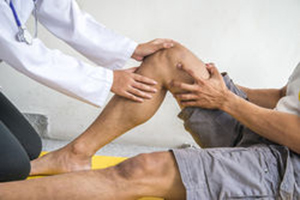
As the name implies, medical compression stockings are used for the unique purpose of addressing chronic health concerns that may affect your mobility.
They can bring effective results in a variety of situations and are often encouraged by doctors.
But what makes these medical compression stockings so special? Here we share what you need to know about these helpful support stockings and how they can help support your heath and mobility.
What are Medical Support Hose?

Before we delve into the power of medical support hose, we should first understand what these supportive stockings are.
These knee-high or thigh-high socks are medical-grade garments that help the movement of blood.
The support provided by this legwear is divided into various levels.
These levels are measured in mmHg, which is a measurement of pressure, and range from Mild (8-15 mmHg) and Medium (15-20 mmHg) to Firm (20-30 mmHg) and X-Firm (30-40 mmHg).
Choosing the right pressure level can ensure that the compression socks will be effective in serving the purpose they’re used for.
Who Should Use Support Hose?
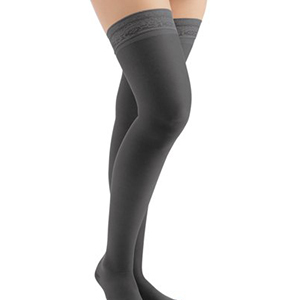
Compression stockings can provide relief for a variety of medical conditions. Medical support stockings are worn by people dealing with ailments such as:
- Mobility issues
- Varicose veins
- Spider veins
- Deep Vein Thrombosis (DVT)
In addition to those suffering from health concerns, support hose can also provide benefits for people who may not be dealing with such ailments.
People who may also find great benefit in using compression socks include:
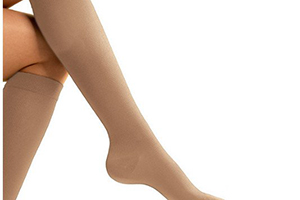
- Pregnant Ladies
- Athletes
- Runners and marathoners
- Nurses
- Post-operative patients
- Travelers on long flights
- Those who spend a lot of time standing during the day (i.e. nurse, etc.)
Your reasons for getting compression hosiery also depend on your condition or symptoms.

Here are some common conditions or ailments that can be improved through the use of supportive compression sock therapy:
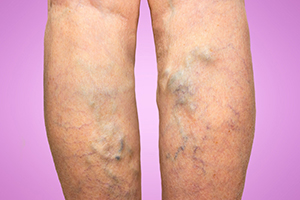
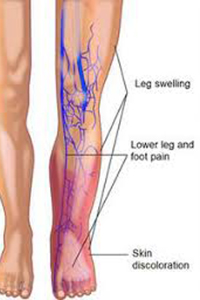
- Pregnancy-related swelling
- Varicose Veins
- Lymphedema
- Swelling, blood clots or pain in the lower legs known as
- DVT (Deep Vein Thrombosis)
- Poor circulation from sitting for long periods
- Post-Sclerotherapy and post-surgical treatment
Below are some of the ways compression socks help to alleviate these medical conditions and other ailments:
Reduce Discomfort
One of the benefits of wearing support medical socks is that they significantly reduce discomfort. Compression stockings help joint pain, which results in better circulation and improved comfort.
Help Blood Flow
Support socks are beneficial to maintain ideal blood flow. Thigh-high or knee-high support socks help in improving blood circulation. This will result in a healthy body due to better blood flow.
Still, it is advisable to get an opinion from your doctor when choosing the compression strength for your socks.
Treat Varicose Veins
One of the major benefits of wearing support medical socks is treating varicose veins. A varicose vein is a condition where your veins are swollen or enlarged.
At best wearing between 15-30 mmHg compression hosiery will help relieve pain and aches associated with varicose veins compared to wearing normal socks.
Treat Swelling
Graduated 30 – 40 mmHg, 20 – 30 mmHg, or 15 – 20 mmHg knee high or thigh high support socks can help in treating swelling as a result of pregnancy or other medical conditions.
Prevents Fatigue
Wearing 30 – 40 mmHg, 20 – 30 mmHg, or 15 – 20 mmHg knee-high or thigh-high support compression socks is a wonderful way to prevent fatigue. Using the right compression will give you the best health benefit.
Depending on your need, you can choose between different compression strengths.
Prevent Edema
Wearing support compression socks can also help you prevent edema. You will need to have a higher compression level starting with 20-30 mmHg or more to gain the health benefits.
This will help in also treating varicose veins, oedema and prevent post-surgical blood clots and increase blood circulation.
How Do Support Hose Work?
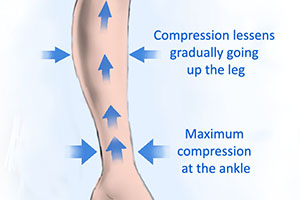
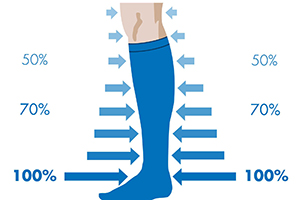
To address such ailments and conditions, supportive compression socks can help to alleviate swelling and provide much-needed relief for your feet.
Support hosiery can be made from different materials and serve essential purposes. While ordinary socks protect your feet and keep them warm, these stockings are highly functional.
They are elastic and fit snugly around the ankle and fit more loosely around the calves.

The knee-high or thigh-high support hose comes in a variety of compression strengths that keep your circulation in your legs healthy.
When you stand for long periods, gravity drives fluid into the veins of your lower legs. Support hosiery applies pressure to your lower legs to prevent blood clots and promote blood flow.
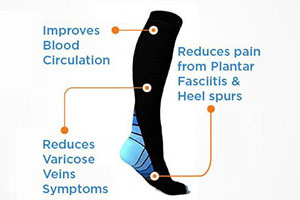
The pressure created by the support hose pushes the fluid up the leg and moves the blood flow to the heart. Support hose reduces pain and swelling.
This pressure and pushing of blood flow is why compression stockings are recommended in the prevention of DVT as the pressure stops the blood from pooling and clotting.
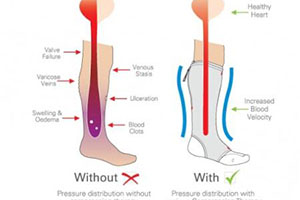
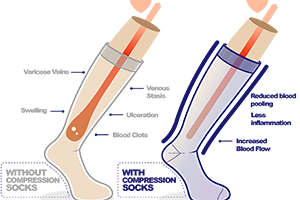
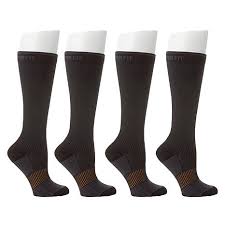
The pressure in your leg veins depends on the distance between your feet and your heart.
Support hose centers the pressure at the ankle and decreases in pressure as it moves up the leg.
This increases the blood flow to your lower extremities like your feet.
There are many types of compression stockings available for purchase without a prescription, particularly lower compression gradients.
However, when you are wearing higher graduated pressure (30 – 40 mmHg, 20 – 30 mmHg, or 15 – 20 mmHg) support hose, you should talk to your health care provider to find out if they are a good choice for you.
If you are experiencing leg trauma or recently had surgery, then your doctor may prescribe either 30 – 40 mmHg, 20 – 30 mmHg, or 15 – 20 mmHg support hose during the recovery period and after a hospital stay. You can also buy this product from the Comprogear store.
How to Use Support Hose

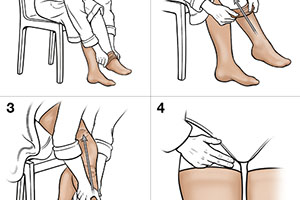
Compression socks can be used as a preventative measure for your health.
For best results, put them on first thing in the morning before you stand up and have any swelling start to develop.
If you put them on after standing and walking, they may be more difficult to put on because your legs will already be swelling.
Remember to take your socks off in the shower and when you go to bed. Be sure not to wear them overnight unless instructed to do so.

In getting your support medical compression socks on, there are a few tricks you can use to make the process easier. Apply lotion to your skin before putting on the tight-fitting support hose to help the material glide up your leg.
However, make sure the lotion is well absorbed into the skin first to prevent moisture and any other bacteria from building up between your leg and sock.

To put on the support hose, grab the top of the stocking and roll it down toward your heel. Then, put your foot inside the sock and slowly unroll the sock as you move it up your leg.
Tools like a stocking donner can help ease the process of putting on the sock.
Types of Support Hose – Thigh High or Knee High Medical Socks
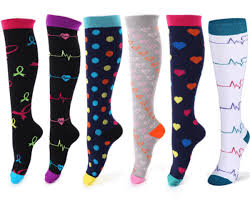
There are three primary types of knee-high or thigh-high support hosiery. These include:
- graduated 30 – 40 mmHg, 20 – 30 mmHg, or 15 – 20 mmHg knee high or thigh high support hose
- non-medical support hosiery
- anti-embolism hoe
Graduated Compression Socks
In graduated 30 – 40 mmHg, 20 – 30 mmHg or 15 – 20 mmHg knee high or thigh high support hose, the pressure level is strongest at the ankle and the pressure gradually decreases towards the top.
They are designed to meet certain strengths and lengths for mobility. These stockings generally require professional fitting.
Support hose that ends below the knee help limits peripheral oedema or leg swelling as a result of fluid buildup.
There are variants that extend to the thigh or waist to reduce pooling of blood in legs, thus preventing orthostatic hypotension. Some medical stockings suppliers offer personal preferences such as open or closed-toe and color.
Non-medical Support stockings
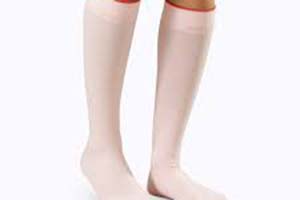
These support hose do not necessarily require a prescription, but they do offer relief for aching legs.
These can be great options for people who are not suffering from medical concerns but are looking for general relief from aching feet and legs.
Anti-embolism socks

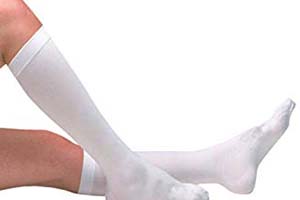
Anti-embolism support hose help reduce the likelihood of deep vein thrombosis (DVT).
Just like the graduated socks, they offer gradient medical pressure, but the level of compression differs. These types of supportive legwear are designed for those who are immobile.
These support garments are worn after the diagnosis of DVT to reduce discomfort and swelling. Previously the support hose used to be worn after acute DVT to negate post-thrombotic syndrome. However, this is no longer the case.
Socks for athletes and runners
These types of medical stockings are common and popular for both men and women. They come in a variety of sizes, patterns and colors. They usually have a low level of compression and would not work in medical treatment.
Many athletes like wearing them. Studies have shown that socks improve athletic performance and recovery because they prevent blood from pooling. These types of support hose don’t require a prescription because of the low to moderate compression.

Prescription socks
There are many conditions in which doctors will prescribe medical socks due to blood circulation issues like deep vein thrombosis.
Sometimes, people with DVT still have swelling, pain or other symptoms after the blood clot is gone. This is referred to as PTS (Post-Thrombotic Syndrome). People with this condition may benefit from support hose. If you need this type of support hose, you should get a prescription from your doctor.
The doctor will prescribe a specific amount of pressure called compression strength. They will also measure your leg and custom fit them according to your healthcare provider’s prescription.
These support hose are classified by a roman numeral and indicate the pressure applied. The ankle pressure also indicates the grade of the socks. For example, class 1 socks will apply 20-30 mmHg pressure at the ankle while a class IV sock will apply a pressure of 50-60 mmHg.
TED Socks
There are Thrombo-Embolic deterrent (TED) socks, too. These exert less pressure than most prescription socks. They are recommended for people who have just had surgery or for people who are immobile. The lower pressure helps in improving blood circulation and preventing blood clots when you are immobile.
However, they do not have enough compression strength to treat problems such as DVT for anybody active.

Choosing the Right Knee High or Thigh High Support Hose
Choosing your medical socks can be overwhelming. There are many varieties available that vary in length, style, material, size and medical compression level.
These factors should guide you when searching for your compression socks. However, if you are wearing support hose due to a medical condition, your health care provider is your best resource.

The size of sock is one of the most important factors to incorporate in your decision of which sock is best for you. See the measurement chart below to determine your size based on what kind of compression socks you desire.
For example, your shoe size will greatly influence whether you select a knee sock or an over-the-knee sock. Full medical stockings are usually sized regularly in department stores.
The size is based on a ratio between weight and height. Others may require measurements for ankle circumference, calf length and calf circumference.
Size
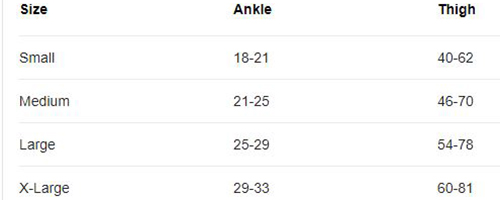
Material

The material used to make 30 – 40 mmHg, 20 – 30 mmHg or 15 – 20 mmHg knee-high or thigh-high support hose will depend on the need for the compression socks.
Some are made of lycra, rubber or spandex and they come in different lengths like knee, thigh or full.
If your need for 30 – 40 mmHg, 20 – 30 mmHg or 15 – 20 mmHg knee-high or thigh-high support hose is because you stand or sit for long periods, then you need to choose a sock that is comfortable for you.
Compression

The level of support you need will depend on your need for 30 – 40 mmHg, 20 – 30 mmHg, or 15 – 20 mmHg knee-high or thigh-high support hose. The standard level of support include:
- Light-moderate compression, 15 – 20 mmHg – These are perfect for travelling. If your work entails standing all day, if you are pregnant or are experiencing mild leg swelling, these types of support hose will come in handy.
- Moderate compression, 20 – 30 mmHg – These are great for legs that experience moderate swelling and varicose veins because of pregnancy or another condition. You can also wear them when your legs feel tired and heavy.
- Firm compression, 30 – 40 mmHg – These are usually required when you have moderate to severe varicose veins, moderate oedema or after vein treatment such as vein stripping. They also come in handy for combating lymphedema.
- Extra firm compression, 40 – 50 mmHg – They help with severe edema, or varicose veins, chronic venous diseases or severe post-thrombotic syndrome.
- Heavy compression, 50 – 60 mmHg – This is the strongest standard compression level and is primarily used in relieving Post Thrombotic Syndrome and lymphedema.
Style
You should also choose a style that will fit perfectly with your attire. There are options from solid colors to various designs, depending on your desire and use.
Compression stockings used to be only for sick people with serious swelling or clotting issues. But this is not the case anymore- in recent years, their popularity has increased.
For instance, athletes wear support hose in the hopes of increasing their performance. The needs of a runner may differ from those with a medical condition.
There are different compression levels available in the market. Different support stockings do distinctive things and here is how you can figure out what would work best for you.
Side Effects of Using the Wrong Pressure Hose

As with many things, compression socks offer wonderful benefits. However, if you’re not careful, there can be some negative side effects. This may be due to ignoring several factors when choosing graduated socks. Factors like size, material, compression strength and style can cause serious side effects.
What are the drawbacks to support hose?
When used incorrectly, compression socks can cause pain in your legs after removing them. They can also cause discomfort or an unpleasant sensation in the legs while wearing graduated socks. This can also occur when the socks are worn for long periods of time.
As a recommendation, compression socks should be worn during the day and removed before going to bed. During sleep, gravity will have the same effect on the legs as the compression stockings while awake.
Some users may develop hardened layers of skin on the foot as it tries to protect itself against pressure and friction. These are called corns and calluses. They can form on the toes or feet from very tight compression. This is why it is essential to choose the right compression strength.
If incorrectly chosen, paresthesia can occur. This happens when the compression socks are too tight for your legs. This means that poor-fitting support hose can cause numbness and tingling feet.
Another side effect of not choosing the correct compression strength is skin irritation and itching throughout the compressed area. If this occurs, your skin may be reacting from the material in the compressed socks.
Other negative side effects in wearing supportive compression socks include:
Joint pain in knees
Compression hose will actually help in relieving joint pain in knees, but when you wear the wrong size, you might experience pain. If this happens, make sure you contact your healthcare provider immediately.
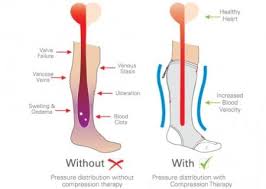
Loss of circulation
Higher compression strength may be counterproductive as it exerts more pressure on the foot and stops blood circulation.
Spasms and swelling in toes
If you experience violent, involuntary or sudden contractions in your toes, which are accompanied by pain, you may be using the wrong compression strength. You should ask a medical professional to help you choose the right compression to mitigate the pain.
Tips for Wearing Pressure Hose
Compression socks can be purchased online in the Comprogear store. To help your socks last long and be most effective, there are some helpful things you can do to make them work best for you.
Taking care of support hose includes washing the support hose with mild soap and air drying them for longevity. You should also replace your compression stockings every four to six months.
Find the right size, length, color, and compression strength depending on your personal and health needs.
Conclusion

Compression socks have been designed to apply pressure to your ankles and legs to help increase blood circulation to your lower limbs. You can purchase these types of socks over the counter but higher compression strengths need a doctor’s prescription.
If buying over the counter, get the right fit to avoid some of the side effects mentioned above. Make sure that you get fitted properly, follow instructions for the proper use and monitor any skin changes so that you can adjust accordingly.
Compression socks provide many health benefits. It will protect your legs from scratches and dirt and also help in preventing blood clots and improving blood flow. It can be beneficial for travelers, nurses, athletes, and pregnant ladies.
This page last updated November 5, 2022
